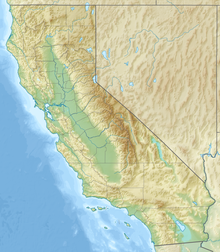Eureka (ferryboat)

Eureka docked at Hyde Street Pier
|
|
| History | |
|---|---|
|
|
|
| Name: |
|
| Builder: | San Francisco and North Pacific Railroad, Tiburon, California |
| In service: | 1890-1958 |
| Refit: | 1920-22 |
| Status: | Museum ship |
| General characteristics | |
| Type: | Steamboat |
| Tonnage: | 2,420 GT |
| Length: | 299 ft 6 in (91.29 m) LOA |
| Beam: | 78 ft (24 m) |
| Propulsion: | 1 × 1,500 hp (1,119 kW) walking beam engine |
| Capacity: |
|
|
Eureka (double-ended ferry)
|
|

View from port stern
|
|
| Location | San Francisco, California |
| Coordinates | 37°48′35″N 122°25′18″W / 37.80972°N 122.42167°WCoordinates: 37°48′35″N 122°25′18″W / 37.80972°N 122.42167°W |
| Built | 1890 |
| NRHP Reference # | 73000229 |
| Significant dates | |
| Added to NRHP | April 24, 1973 |
| Designated NHL | February 4, 1985 |
Eureka is a side-wheel paddle steamboat, built in 1890, which is now preserved at the San Francisco Maritime National Historical Park in San Francisco, California. Originally named Ukiah to commemorate the railway's recent extension into the City of Ukiah, the boat was built by the San Francisco and North Pacific Railroad Company at their Tiburon yard. Eureka has been designated a National Historic Landmark and was listed in the National Register of Historic Places on April 24, 1973.
The ship originally carried commuters between San Francisco and Tiburon during the day and hauled railroad freight cars at night. In 1907, Ukiah was re-routed to the Sausalito–San Francisco Ferry Building route by its new owners, Northwestern Pacific Railroad.
As automobiles became more common, motorists wanted to "drive across the bay". Since there were no bridges on San Francisco Bay at the time, Ukiah was able to meet this demand via a refitted lower deck designed to handle vehicles. The deck above (also enclosed) was expanded for passengers.
During World War I, Ukiah carried munition-filled rail cars for the war effort. Overloading of the ship caused hull strains so severe that the government paid for complete rebuilding of the ship. Shipwrights at the Southern Pacific yard labored for two years—eventually replacing all of its structure above the waterline. This kind of reconstruction was called "jacking up the whistle and sliding a new boat underneath." The refurbished ferry was christened Eureka in honor of the Northern California city, which also happened to be the new northern termination of the Northwestern Pacific Railroad.
...
Wikipedia

